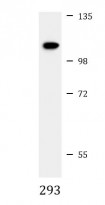ARG55821
anti-MAGED1 antibody
anti-MAGED1 antibody for Western blot and Human
Overview
| Product Description | Mouse Monoclonal antibody recognizes MAGED1 |
|---|---|
| Tested Reactivity | Hu |
| Tested Application | WB |
| Host | Mouse |
| Clonality | Monoclonal |
| Clone | 1305CT862.157.127 |
| Isotype | IgG1, kappa |
| Target Name | MAGED1 |
| Antigen Species | Human |
| Immunogen | KLH-conjugated synthetic peptide corresponding to aa. 20-224 (Center) of Human MAGED1. |
| Conjugation | Un-conjugated |
| Alternate Names | DLXIN-1; Neurotrophin receptor-interacting MAGE homolog; Melanoma-associated antigen D1; MAGE tumor antigen CCF; NRAGE; MAGE-D1 antigen |
Application Instructions
| Application Suggestion |
|
||||
|---|---|---|---|---|---|
| Application Note | * The dilutions indicate recommended starting dilutions and the optimal dilutions or concentrations should be determined by the scientist. | ||||
| Positive Control | 293 |
Properties
| Form | Liquid |
|---|---|
| Purification | Purification with Protein G. |
| Buffer | PBS and 0.09% (W/V) Sodium azide |
| Preservative | 0.09% (W/V) Sodium azide |
| Storage Instruction | For continuous use, store undiluted antibody at 2-8°C for up to a week. For long-term storage, aliquot and store at -20°C or below. Storage in frost free freezers is not recommended. Avoid repeated freeze/thaw cycles. Suggest spin the vial prior to opening. The antibody solution should be gently mixed before use. |
| Note | For laboratory research only, not for drug, diagnostic or other use. |
Bioinformation
| Database Links | |
|---|---|
| Gene Symbol | MAGED1 |
| Gene Full Name | melanoma antigen family D1 |
| Background | This gene is a member of the melanoma antigen gene (MAGE) family. Most of the genes of this family encode tumor specific antigens that are not expressed in normal adult tissues except testis. Although the protein encoded by this gene shares strong homology with members of the MAGE family, it is expressed in almost all normal adult tissues. This gene has been demonstrated to be involved in the p75 neurotrophin receptor mediated programmed cell death pathway. Three transcript variants encoding two different isoforms have been found for this gene. [provided by RefSeq, Jul 2008] |
| Function | Involved in the apoptotic response after nerve growth factor (NGF) binding in neuronal cells. Inhibits cell cycle progression, and facilitates NGFR-mediated apoptosis. May act as a regulator of the function of DLX family members. May enhance ubiquitin ligase activity of RING-type zinc finger-containing E3 ubiquitin-protein ligases. Proposed to act through recruitment and/or stabilization of the Ubl-conjugating enzyme (E2) at the E3:substrate complex. Plays a role in the circadian rythm regulation. May act as RORA co-regulator, modulating the expression of core clock genes such as ARNTL/BMAL1 and NFIL3, induced, or NR1D1, repressed. [UniProt] |
| Cellular Localization | Cytoplasm. Cell membrane; Peripheral membrane protein. Nucleus. Note=Expression shifts from the cytoplasm to the plasma membrane upon stimulation with NGF. |
| Calculated MW | 86 kDa |
Images (1) Click the Picture to Zoom In






